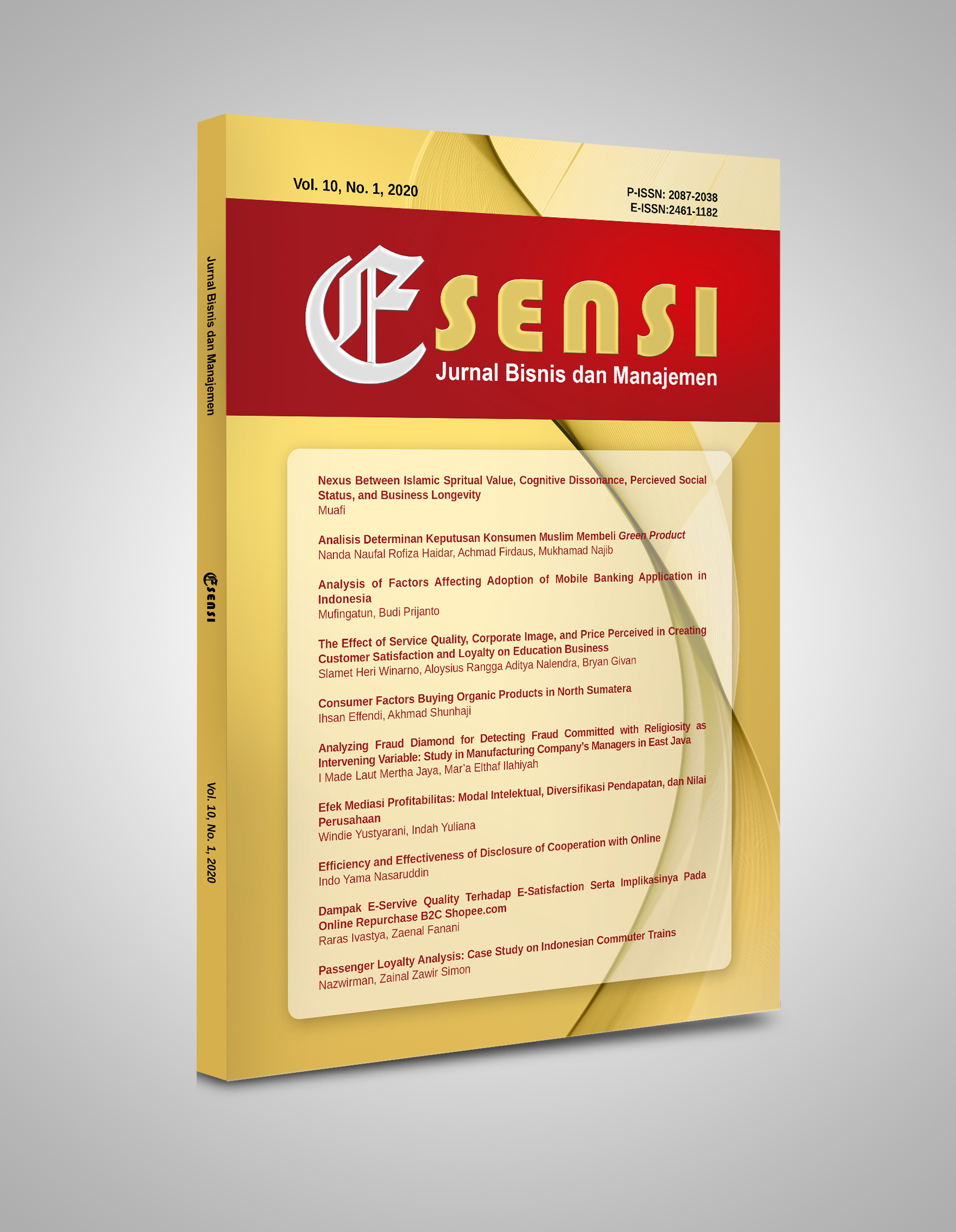Analyzing Fraud Diamond for Detecting Fraud Committed with Religiosity as Intervening Variable: Study in Manufacturing Company’s Managers in East Java
DOI:
https://doi.org/10.15408/ess.v10i1.14878Keywords:
Fraud, Manajemen Keuangan, dan Religiusitas.Abstract
This research was conducted to find out the reasons why a manager commits fraud. Diamond fraud model was used in this research. Religiosity variables are used as intervening variables to determine the effect of religiosity in intervening fraudulent actions among managers of manufacturing companies in East JavaThe data analysis techniques used in this study were descriptive analysis and path analysis. The results of the analysis test in this study resulted in several conclusions, namely the Fraud diamond factor proved to have a significant effect on fraud (Fraud) committed by managers of manufacturing companies in East Java. Meanwhile, Fraud diamond (Incentive) factors proved to have no significant effect on fraud (Fraud) committed by managers of manufacturing companies in East Java. In addition, Religiosity was also not able to interfere strongly with the relationship between Fraud diamond on fraud (Fraud) committed by managers of manufacturing companies in East Java. In conclusion, this result of this research proves that the level of religiosity of a manager is not necessarily able to suppress fraud that is committed in the company.
References
ACFE. 2016. Report to The Nation on Occupational Fraud and Abuse. Austin, Texas: Association of Certified Fraud Examiners.
ACFE. 2014. Report to the Nations on Occupational Fraud and Abuse. Austin: ACFE.
Albrecht,W.Steve Dkk. 2012. Fraud Examination. South-Western: Cengage Learning (http://books.google.co.id/books?id=SBzJYBsFPIC&pg=PA5&dq=fraud+triangle&hl=id&sa=X&ei=BdgxVNS9GMOPuASW6YBg&redir_esc=y#v=onepage&q=fraud%20triangle&f=false)
Allport, G. W., and Ross, J. M. 1967. Scales of religious orientation. Journal of Personality and Social Psychology , 144-154.
Annisya, Lindrianasari, dan Asmaranti, 2016. Pendeteksian Kecurangan Laporan Keuangan Menggunakan Fraud Diamond, Jurnal Vol. 2 No. 1 h.72. Lampung: Fakultas Ekonomi dan Bisnis.
Basri, Hasan. 2015. Paradigma Baru Sistem Pembelajaran. Bandung: Pustaka Setia.
Conroy, S. and Emerson, T. 2004. Business Ethics and Religion: Religiosity as a Predictor of Ethical Awarenesss among Students. Journal of Business Ethics, 50 (4), 383-396.
Cressey, D. R. 1953. Other People’s Money. Montclair, NJ: Patterson Smith, pp.1-300.
Dechow, P. M. 1994. Accounting earnings and cash flows as measures of firm performance. The role of accounting accruals. Journal of Accounting and Economics 18: 3-42.
Farber, B.A. 1991. Crisis and education: Stress and burnout in the American teacher. San Fransisco: Jossey Bass
Fishbein, M. and Ajzen, I. 1975. Belief, Attitude, Intention, and Behavior: An Introduction to Theory and Research. Reading, MA: Addison-Wesley.
Glock and Stark. 1965. Religion and Society in Tension. Chicago: Rand Mc Nally.
Manurung, D. T. H., dan Hardika, A. L. 2015. Analysis of factors that influence financial statement fraud in the perspective fraud diamond : Empirical study on banking companies listed on the Indonesia Stock Exchange year 2012 to 2014. Paper dipresentasikan di International Conference on Accounting Studies 2015, Johor, Johor Baru, Malaysia, 17-20 Agustus.
Purnamasari, E. 2014. Pengaruh Religiusitas tentang Pelanggaran Etika pada Siswa Kelas XI MIA 4 & XI IIS 2 SMA Negeri 14 Bandung. TARBAWY, 2(1), 155-166.
Sihombing. 2014. Analisis fraud diamond Dalam Mendeteksi financial Statement Fraud: Study Empiris Pada Perusahaan Manufaktur yang Terdaftar di Bursa Efek Indonesia (BEI). Journal of Accounting, Vol 03, No 02, h.3, Semarang: Universitas Diponegoro.
Skousen. et al., 2009, Consideration of Fraud in a Financial Statement Audit. SAS No.99
Sujarweni, V. Wiratna. 2018. Panduan Mudah Olah Data Struktural Equation Modeling (SEM) Dengan LISREL. Pustaka Baru Press: Yogyakarta.
Wolfe, David T.; Hermanson, Dana R. 2004. The Fraud Diamond: Considering the Four Elements of Fraud. CPA Journal; Dec2004, Vol. 74 Issue 12, p38.
Zimbelman, Mark F, dkk. 2014. Akuntansi Forensic. Edisi 4. Jakarta: Salemba Empat.


